In the midst of the UK’s renewable energy revolution, Nadia Narayan, Jon Gluyas and Charlotte Adams aim to identify and quantify the nation’s karst geothermal resources in Carboniferous Limestone
Narayan, N., Gluyas, J. & Adams, C., Is the UK in Hot Water.
Geoscientist 28 (9), 10-15, 2018
https://doi.org/10.1144/geosci2018-014; Download the pdf here
Above, God’s Bridge (natural limestone bridge) over the River Greta, Teesdale, Durham. Designated Site of Special Scientific Interest
Rewind to 31st December 1973, the UK is experiencing an energy crisis. The Organisation of Petroleum Exporting Countries (OPEC) Arab oil states have imposed an oil embargo, causing a stock market crash. The coal miners are on strike in defiance of their low wages. Coal supplies are diminishing and tonight the lights go out. Commercial businesses will only be allowed to consume electricity three days a week. The UK is at its most vulnerable. What is the next move?
Reaction to a crisis
The events of 1973 placed the UK in an alarming position, refocusing attention on energy security and inciting a wave of investment into research and development programmes in renewable energy. Commencing in 1974, nationwide assessments of geothermal, wind, wave, solar, biomass (and continued interest in nuclear resources) were established. The geothermal assessment (1977-1984), conducted by the British Geological Survey and sponsored by the then Department of Energy and the Commission of European Communities, identified several deep geothermal targets in Mesozoic sedimentary basins and radiothermal granites but failed to quantify pre-Permo-Triassic prospects.
By 1994 the geothermal programme had come to an end, in part due to the lack of identifiable high-temperature resources, but also due to falling fossil fuel prices and the remarkable emergence of the UK’s status as a large oil-and-gas-producing nation: increased investment in North Sea oil and gas production meant the UK became a net energy exporter in 1981, with a contribution of 4.6% indigenous oil to global production by 1985.
Yet, by 2004 the UK’s oil and gas production had fallen such that both were again imported, returning to a situation that existed pre-1981 and pre-1997. During the cyclical years of plenty, the role of gas changed dramatically. It became, and still is, the mainstay of UK power production and further development of the national grid meant increased use of gas for heating in domestic and industrial settings. The current planned demise of coal and consequent loss of manufactured gas means that the UK is now highly dependent upon the security of natural gas supply and thus on imports.
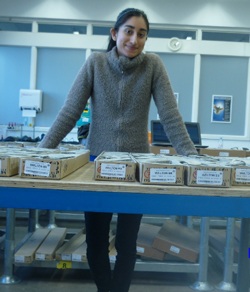 Left, Nadia Narayan, PhD student at Durham University, looking at Carboniferous Limestone at the Core Store Repository at the British Geological Survey, Keyworth
Left, Nadia Narayan, PhD student at Durham University, looking at Carboniferous Limestone at the Core Store Repository at the British Geological Survey, Keyworth
A starring role
The security of imported energy supplies for power is important, but there is a lack of appreciation of the value of heat. ‘Clean’ nuclear energy and renewable wind and solar energy contribute significantly to today’s electricity energy mix. With the phasing out of coal and the rise in wind power generation, it is no surprise that wind surpassed electricity production from coal in April 2016. Yet, almost 50% of the energy consumption in the UK is used for heat, which is still delivered by burning gas, oil and coal or by consumption of electricity. Only about 1.77% of energy consumption (for heat only) is that sold directly as heat from combined heat and power schemes.
The UK’s approach to decarbonizing heat is to switch domestic and other heat production away from direct use of fossil fuels to electricity. In this way, greenhouse gases can be captured at source—the power station. However, electricity production from gas at the power station is only around 35% efficient; the remaining 65% of the energy liberated from burning the gas goes up the chimney (as unused heat). This is profligate use of energy when the same heat can potentially be sourced locally from geothermal systems.
Although heat cannot be transmitted over the same distance as electricity, geothermal energy is accessible to many areas of the UK at regional scale. Also, unlike wind energy or solar schemes, geothermal energy does not suffer the same intermittencies in production and has the ability to de-carbonise heat supply, with a potential role in providing baseload heat to commercial and residential areas.
The issues of supply security and meeting peak demand became real concerns again in March 2018, during periods of heavy snowfall across the UK. On Thursday 1st March, the National Grid declared a gas deficit warning—the first of its kind in almost a decade. A combination of the arrival of a Siberian cold front, theatrically nicknamed the ‘Beast from the East’, and shortages in gas imports left the National Grid experiencing a deficiency in UK supplies of ~50,000,000 m³. Supplies made a rapid recovery by the Friday, but once again the UK had plummeted into uncertainty. With high dependency on gas imports and high heat consumption, there is a niche for geothermal energy to help tackle these issues.
Development of UK geothermal resources and their compatibility with district heat networks aligns well with government policy aspirations to supply 14-43% of total heat from buildings by district heat networks by 2050. Gluyas et al. (Keeping warm: a review of deep geothermal potential of the UK, 2018) estimate that geothermal exploitation has the capacity to satisfy the current heat demand for 100 years. This could offset the 160 million tonnes of CO2 emitted from fossil fuels due to heat use. Yet, the 1970s-1980s geothermal assessment culminated in producing only a single deep-heat producing well in Great Britain, located in Southampton.
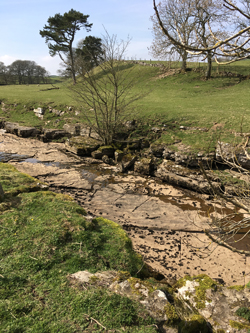 Success story
Success story
The Southampton-1 well was drilled to a depth of 1.8km to reach the target aquifer, the Triassic Sherwood Sandstone. The 76°C waters encountered began delivering heat energy in 1986 as part of the Southampton District Energy Scheme (operated by Engie), which utilizes geothermal energy and combined heat and power (CHP). The initiative was championed by Mike Smith (Director-Cities, Engie), an accountant, and other members of the Southampton City Council after the Department of Energy declined to fund a scheme considered to be lacking in commercial viability. Mike and his team lobbied the Department of Energy to drill the well, secured funding from the European Union and involved the technical expertise of the French company, Utilicom. Since its inception, the scheme has supplied heating and chilling capabilities (via absorption chillers) to offices, a hospital, a civic building, a supermarket, hotels, the university, BBC studios, a swimming pool and more. Annually, the scheme saves 10,000 tonnes of carbon dioxide and generates >40 GWh of heat, 26 GWh of electricity and 7GWh of chilled water.
Right, River Greta cutting through limestone in Teesdale during low flow. In this section of the river, the water follows a subterranean route, having been lost to upstream sinks
At least three further high-profile assessments—Barker et al. (2000), Sinclair Knight Merz (2012) and Atkins (2013)—have been conducted since 1986, with Barker et al. providing the most detailed evaluation of strata older than the Permian out of the three. Have we underestimated the potential of the Lower Carboniferous strata when virtually all warm springs (water issuing several degrees above local ambient temperature) circulate through here?
Karst of thousands
Journey through the caves in the Mendip Hills, Somerset and you will find yourself standing inside karst. Peer into a doline and you will be staring into the depths of time, made possible by karstic processes. Hike on top of the Great Scar Limestone at Malham Cove in Yorkshire and you will be standing on the clints of limestone pavement, riven with grykes—also karstic features. Karst varies considerably in form, but the fundamental process is the same. Broadly, carbonate karst describes a type of terrain typically formed by dissolution via carbonic acid sourced from rainwater and soil (respiring organic matter and decaying organisms) that exploits pre-existing weaknesses in the rock. Evaporites are also susceptible to karst development, albeit dissolving at a higher rate and by the process of disassociation. We can accurately predict temperature with depth, based on the geothermal gradient, but at depths in excess of 1km, permeability is not guaranteed. Buried karst is thus of interest for geothermal energy production because it has enhanced permeability that could reduce the need for hydraulic stimulation and lessen the risk of drilling a well that does not flow.
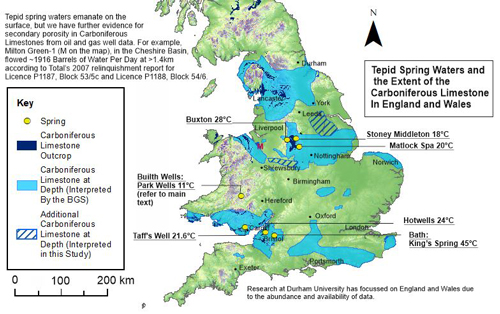 Left, Extent of the Carboniferous limestone outcrop at surface and its equivalent at depth as interpreted by the BGS and this study. Several well-known thermal springs are hosted in the Carboniferous Limestone which also displays evidence of flow at depths exceeding 1km
Left, Extent of the Carboniferous limestone outcrop at surface and its equivalent at depth as interpreted by the BGS and this study. Several well-known thermal springs are hosted in the Carboniferous Limestone which also displays evidence of flow at depths exceeding 1km
There are six basic criteria to consider for the development of karst. The primary factors are lithology and climate. In carbonates, purer limestones containing at least ~70% calcium carbonate are more likely to form karst than impure lithologies that may contain barriers to dissolution, such as clay minerals. Karst development is more likely in temperate to tropical and sub-tropical latitudes. During the deposition of Carboniferous Limestone, Great Britain resided at the equator—a perfect holiday destination consisting of exotic islands (or uplifted blocks) scattered across a tropical Rheic Ocean. At similar latitudes, present-day South China has developed spectacular examples of karst at the surface. At more temperate latitudes, limestone pavements outcrop in the Yorkshire Dales (Northern England), for example, which originated during Quaternary glaciation. Given the definition above, development of karst is likely in areas of high CO2 soil concentration and high rainfall/water percolation.
Extended exposure duration and the existence of a fracture network promotes karst development because there is a greater surface area for dissolution over longer periods of exposure. A steep gradient and change in relief are ideal for increased erosion and dissolution rates. Lastly, increased vegetation cover allows for greater CO2 production as a result of various biogenic processes.
Collectively, the conditions described above are the optimum conditions for karst formation, but other processes, such as dolomitization, can also control the extent of karst.
Dawn of the geothermal industry
In Britain, most thermal spring waters are associated with secondary and tertiary porosity (fractures and karst) in Carboniferous Limestone. Supermarket-bought Buxton water may taste refreshingly cool, but the temperature at source is 27.5°C. Water supplying the thermal springs at Bath, Somerset, emanates at a temperature of approximately ~46°C through Triassic dissolution pipes interpreted by RW Gallois, in 2007, as collapse karst structures. Approximately 1,296m3 of water emanates from the springs each day—equivalent to a hot bath per day for about 16,000 people.
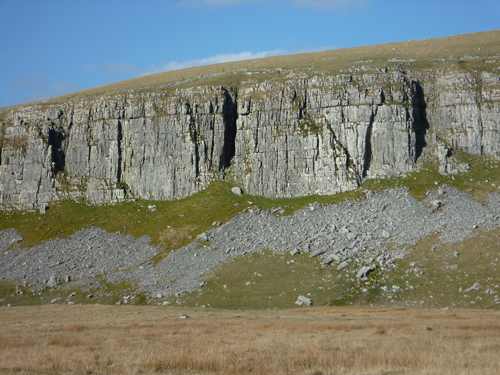 Right, Massive beds of the Great Scar Limestone Group near Malaham Tarn
Right, Massive beds of the Great Scar Limestone Group near Malaham Tarn
The Bath spa springs have been the centre for human activity since at least 8,000 years BC. Legend has it that the springs were officially founded in 863 BC by a Prince Bladud, who was exiled for having contracted leprosy. After becoming a pig herder, the Prince’s herd also developed leprosy. The pigs were cured when they began rolling around in the mud beside the spring waters, so the Prince eagerly followed suit. With his leprosy cured, his exile ended; he soon became King and built the city that we know today as Bath.
Many spring waters—historically and today—are associated with healing properties or rituals involving deities connected to the waters. Some people still make the pilgrimage to springs for their water supply. Societal benefits persist in the form of tourism. In 2015, there were 1 million visitors to the site of the Roman Baths, which is classified as a UNESCO World Heritage Site. Geothermal energy has clearly been incorporated and accepted into society for centuries.
Other thermal springs in Britain are documented at Taff’s well in Wales, Hotwells in Bristol, and at Buxton (which involves a sandstone-carbonate karst conduit flow system) and Matlock Spa (exhibiting associations with deep evaporites) both in Derbyshire, to name a few. Equilibrium temperatures of these spring waters at depth are likely to differ from their surface temperature. Therefore, it is important to analyse and interpret the geochemistry of the waters when prospecting for a geothermal resource.
Oil industry
From an economical point of view, our relationship with karst dates back to the dawn of the nation’s oil industry. A journey to the Oilwell Nursery Garden Centre (Tibshelf, Derbyshire) brings you to the doorstep of Britain’s first oil well: Hardstoft-1. Drilled into the Hardstoft Anticline in 1919 in response to supply threats associated with the First World War, oil was struck at 3,070ft, within Carboniferous Limestone. The well produced about 28,000 barrels of oil until its decline in July 1945. A captivating account of “Hardstoft: Britain’s First Oilfield” can be found in Geoscientist (March 2016, Volume 26, No. 2). Today, the well head still exists, along with the concrete platform remnant of the site of the nodding donkey.
This iconic cornerstone in the nation’s energy industry proved the existence of sufficient secondary/tertiary porosity and permeability in Carboniferous Limestones to support commercial production of oil. Oil and gas drill data also show that water can flow freely through the strata at depth (e.g. drill stem tests in Welton B8, Northeast of Lincoln, East Midlands).
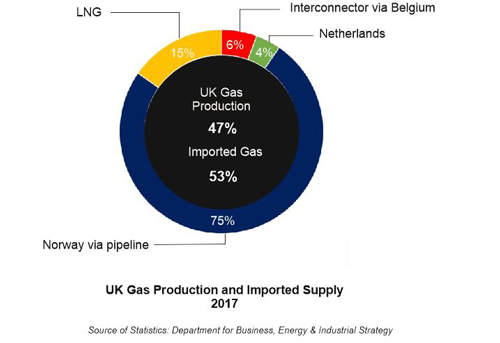 Left, UK Indigenous Gas Supply and Imports in 2017
Left, UK Indigenous Gas Supply and Imports in 2017
Prospecting in deep karst
In addition to mixing, spring waters often undergo conductive and convective heat loss during ascent, causing lower temperatures to be recorded at the surface. But, the spring water contains a geochemical fingerprint of its deeper origins, which can be used in prospecting to calculate the temperature at which the water equilibrated with the host rocks. There are various anion-cation ratios, such as Na-K-Ca, Na-K or Mg-Li indictors, that work as “geothermometers”. At Durham University, this technique has been used in an initial survey of potential Carboniferous Limestone resources across Britain (the study has been limited to Britain because of the abundance of data here) and to demonstrate the viability of pursuing them. For example, a minimum reservoir equilibrium temperature of ~65°C was deduced for the Bath Spa spring waters.
Whilst research at Durham University focusses on the Carboniferous karst, geothermometry has also shown that older strata have potential for geothermal energy exploration. Springs waters from Builth wells springs in Wales, for example, reach the surface at temperatures of just 10-11°C, but anion-cation geothermometry analyses indicate that this water equilibrated at temperatures that may exceed 100°C at depth. Deep circulation in Wales is inferred in the published literature (Further Reading). At Durham a database of spring water chemistry, accumulated primarily through literature studies, water authorities and some field studies, has been compiled for the Carboniferous Limestone investigation.
Bath Spa springs indicate that karst can transport hot water and a primary factor of our project involves the identification of these permeable formations at depth. 2D onshore seismic data has been used to evaluate the distribution of post-Carboniferous Limestone unconformities in the geological record, based on the knowledge that karst can form during times of aerial exposure. The presence of an unconformity of any age overlying a limestone interval provides an ingress point for fluids that can dissolve the limestone and create karst. The karst itself may extend to areas unaffected by unconformities on the top surface of the limestone, but the presence of an unconformity above or nearby increases the chance of success when hunting for karst. Investigation into the number of opportunities for karst development and exploration is the driving force behind our project. For example, unconformable surfaces with karst development at the base of Triassic strata are present at Bath, but we also know they are present in the East Midlands area, where palaeokarst or ancient karst is identified (in conjunction with core data) at the base of a Namurian unconformity.
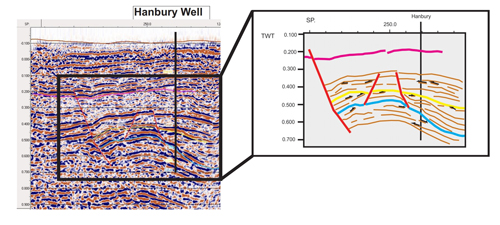
Above, An example of a typical 2D reflection seismic line from the dataset used at Durham University, courtesy of the UK Onshore Geophysical Library. Line CLY-CM88-03 at Hanbury, South of the Derbyshire Dome showing an unconformity on the top of the Carboniferous Limestone (blue), the top of the Namurian (pink) and an intervening unconformity (yellow). Interpretation of 2D seismic unconformities on the Carboniferous Limestone offer an initial idea of surfaces where karst may be potentially found.
Petroleum well data are also essential for determining subsurface properties, because they can provide information on flow rates and well temperatures, and highlight the presence and heterogeneity of karst-fracture systems.
The combination of well, geochemical and seismic techniques allows identification of possible geothermal targets within the Carboniferous Limestone at depth at various locations across the UK. Once all elements of the project are collated, we aim to produce a blueprint of potential karst geothermal resources and will add to the already identified resource base, as detailed in Downing and Gray (1986) and subsequent publications. How big is the UK’s karst geothermal resource? We can’t yet answer that question but we anticipate that it is comparable to that identified in the Mesozoic sedimentary basins.
The UK is in the midst of a renewable revolution. The nation has harnessed the sun and tackled the wind. It is time to tame the Earth.
Nadia Narayan*, Jon Gluyas and Charlotte Adams
Earth Sciences, Durham University; *e-mail: [email protected]
Further Reading
Backhouse, R. (1991) Applied UK Macroeconomics. Oxford: Basil Blackwell.
Barker, J.A., et al. (2000) Hydrogeothermal studies in the United Kingdom. Quarterly Journal of Engineering Geology and Hydrogeology 33, 41-58.
Brassington, F.C. (2007) A proposed conceptual model for the genesis of the Derbyshire thermal waters. Quarterly Journal of Engineering Geology and Hydrogeology 40, 35–46.
Craig, J. et al. (2016) ‘Hardstoft Britain’s First Oil Field’, Geoscientist, 26 (2), 12-17.
Downing, R.A. & Gray, D.A. (Eds) (1986) Geothermal Energy-the Potential in the United Kingdom. London: HMSO.
Edmunds, W.M., Robins, N.S. & Shand, P., (1998). The saline waters of Llandrindod and Builth, Central Wales. Journal of the Geological Society 155 (4), 627-637.
Engie. N/A, Southampton, viewed 8th June 2018, Available at:
https://business.engie.co.uk/embedded-generation/district-energy/southampton/
Ford, D.C. & Williams, P. (2007) Karst Hydrogeology and Geomorphology. John Wiley: Chichester.
Gallois, R.W. (2007) The formation of the hot springs at Bath Spa, U.K. Geological Magazine 144, 741-747.
Gluyas, J. G., et al. (2018) Keeping warm: a review of deep geothermal potential of the UK. Proceedings of the Institution of Mechanical Engineers, Part A: journal of power and energy 232 (1), 115-126.
Gunn, J., et al. (2006) Deep groundwater flow and geochemical processes in limestone aquifers: evidence from thermal waters in Derbyshire, England, UK. Hydrogeology Journal 12 (6), 869-881.
Sinclair Knight Merz (SKM) (2012) Geothermal potential in Great Britain and Northern Ireland. Accessed on 8th June 2018. Available at:
https://www.r-e-a.net/upload/skm_report_on_the_potential_for_geothermal_energy_in_gb__ni_may_2012.pdf